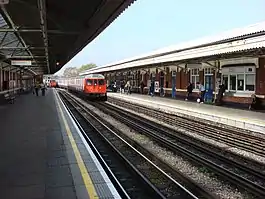Ladbroke Grove tube station
Ladbroke Grove is a London Underground station on the Circle and Hammersmith & City lines, between Latimer Road and Westbourne Park stations, and in Travelcard Zone 2 set in The Royal Borough of Kensington and Chelsea.
| Ladbroke Grove | |
|---|---|
 | |
 Ladbroke Grove Location of Ladbroke Grove in Greater London | |
| Location | Ladbroke Grove |
| Local authority | Kensington and Chelsea |
| Managed by | London Underground |
| Number of platforms | 2 |
| Fare zone | 2 |
| London Underground annual entry and exit | |
| 2015 | |
| 2016 | |
| 2017 | |
| 2018 | |
| 2019 | |
| Railway companies | |
| Original company | Hammersmith and City Railway |
| Pre-grouping | Hammersmith and City Railway |
| Post-grouping | Hammersmith and City Railway |
| Key dates | |
| 13 June 1864 | Opened as Notting Hill |
| 1869 | Renamed Notting Hill (Ladbroke Road) |
| 1880 | Renamed Notting Hill and Ladbroke Grove |
| 1 June 1919 | Renamed Ladbroke Grove (North Kensington) |
| 1938 | Renamed Ladbroke Grove |
| 13 December 2009 | Circle line service introduced |
| Other information | |
| External links | |
| WGS84 | 51.5172°N 0.2106°W |
History
Originally opened by the Hammersmith and City Railway on 13 June 1864, the station was originally named Notting Hill. With the extension of that line from Paddington to Hammersmith it was renamed Notting Hill & Ladbroke Grove in 1880 and Ladbroke Grove (North Kensington) on 1 June 1919 before acquiring the present name in 1938. The renamings were efforts to avoid confusion with the opening of Notting Hill Gate tube station, which had occurred in 1868. The station is named after the street of the same name, where its main entrance is located.
The station is the nearest to Portobello Road Market and market traders and shopkeepers in the market have started a campaign to have the station renamed Portobello Road in an effort to strengthen recognition of the market's proximity.[4]
In 2009, because of financial constraints, TfL decided to stop work on a project to provide step-free access at Ladbroke Grove and five other stations, on the grounds that these are relatively quiet stations and some are already one or two stops away from an existing step-free station.[5] Ladbroke Grove is two stops away from Wood Lane which has step-free access. The project at Ladbroke Grove would have provided two new lifts to platform level and a new step-free entrance. £3.06 million was spent on Ladbroke Grove before the project was halted.[6]
Gallery
 View from the Westbound platform
View from the Westbound platform Ticket Office
Ticket Office View from the Eastbound platform
View from the Eastbound platform Roundel
Roundel
See also
References
- "Multi-year station entry-and-exit figures (2007–2017)" (XLSX). London Underground station passenger usage data. Transport for London. January 2018. Retrieved 22 July 2018.
- "Station Usage Data" (CSV). Usage Statistics for London Stations, 2018. Transport for London. 21 August 2019. Retrieved 27 April 2020.
- "Station Usage Data" (XLSX). Usage Statistics for London Stations, 2019. Transport for London. 23 September 2020. Retrieved 9 November 2020.
- Let's call it Portobello Road Tube, Evening Standard, 30 June 2006
- "Disability and Deaf Equality Scheme (DES) 2009-2012". TfL. Archived from the original on 25 April 2012. Retrieved 1 December 2010.
- "TfL wastes £64million abandoning disabled access plans on the Tube". Evening Standard. 21 April 2010. Archived from the original on 24 October 2012. Retrieved 6 December 2010.
External links
| Wikimedia Commons has media related to Ladbroke Grove tube station. |
- London Transport Museum Photographic Archive
- Lily Allen video on YouTube Video featuring Ladbroke Grove tube station (1 min 54 - 2 min).
| Preceding station | Following station | |||
|---|---|---|---|---|
towards Hammersmith | Circle line | |||
| Hammersmith & City line | towards Barking |
|||
| Former services | ||||
towards Hammersmith | Metropolitan line Hammersmith branch (1864-1990) | towards Paddington |
||